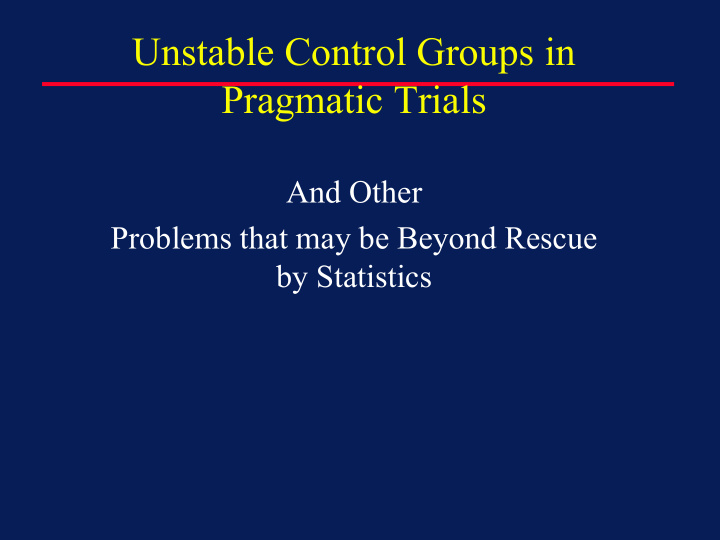



Unstable Control Groups in Pragmatic Trials And Other Problems that may be Beyond Rescue by Statistics
Agenda Description Discussion on exploring techniques to anticipate changes in the control group. This is a major challenge for PCTs. Approaches such as stepped-wedge design, adaptive interventions/smart design, and adaptive designs are options. Small strategic ancillary studies may help investigators measure mediators without complicating PCT designs
Disclaimer More complex designs are not necessarily the solution – adjustment is not a panacea Statistics can ’ t always come to the rescue Anticipation and careful monitoring are critical
Outline Issues most relevant to control sites Other issues not restricted to control sites –Too general a topic to fully discuss –Important to mention Defense reminder for each topic Discussion encouraged
Contamination with elements of Intervention Some components of intervention may appear in usual care for some control sites One strategy is very complex intervention – Difficult to duplicate – BUT also difficult to generalize if successful Defense: Important to recognize and monitor intervention-like activities using same instruments and procedures
Evolving Adoption of Intervention Broad new Healthcare Initiatives focus on same problem Growing awareness drives local efforts (eg, overuse of pain killers) Defense: Again, important to monitor and document whenever possible. Statistics: look for differentially evolving trends in outcomes among controls that are adopters
Changes in Leadership Possible re-focusing of priorities Initial agreements no longer hold Can happen in both control and intervention sites; maybe differentially Defense: Important to have clearly specified MOUs to document what each side has agreed to do. Statistics: Sometimes possible to adjust or evaluate trends
Structural changes, eg Reorganization Sites close or merge Healthcare delivery model is revamped to address newer performance metrics Defense: Discussions of these possibilities should be addressed during recruitment
Fundamental Data Issues Developments that change meaning of the data – Changes in use of diagnostic codes (ICD9 to 10) – Newer technology changing eligibility or outcomes measurement – Could be differentially adopted Threats to definition of target population and comparison of outcomes Defense: Important to be able to monitor and to the extent possible to “ try ” to adjust
Trial or Site Imposed Data Differences Changing eligibility, eg to remedy low accrual rates Differences across clinics in ordering of checkbox codes, eg according to specialty Threats to definition of target population and also outcomes measurement Defense: Monitoring and Communicating to anticipate, record, and possibly adjust
Other Types of Study Modifications Enriching the population during the trial for higher baseline risk to increase event rate in controls Creates evolving target population Statistics: – Complicated trade-off between event rate and accrual rate – Involves potential interaction between intervention and estimated baseline risk?
Site Withdrawal due to Burden Some conditions of participation become onerous Proactive MOU should – Identify site responsibilities – Define eligible population – Specify activities to be conducted by research team Defense: Preliminary small pilot study can help
Balancing Act
Involves incredible cooperation and teamwork
Getting everyone on the same page
Recommend
More recommend